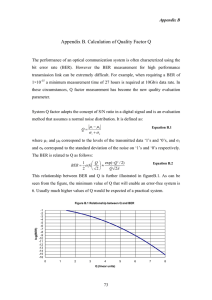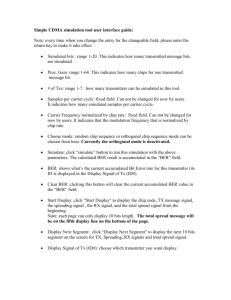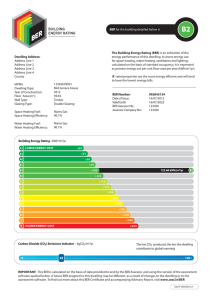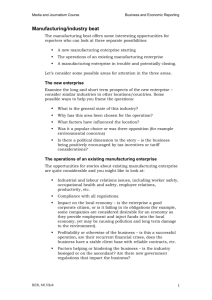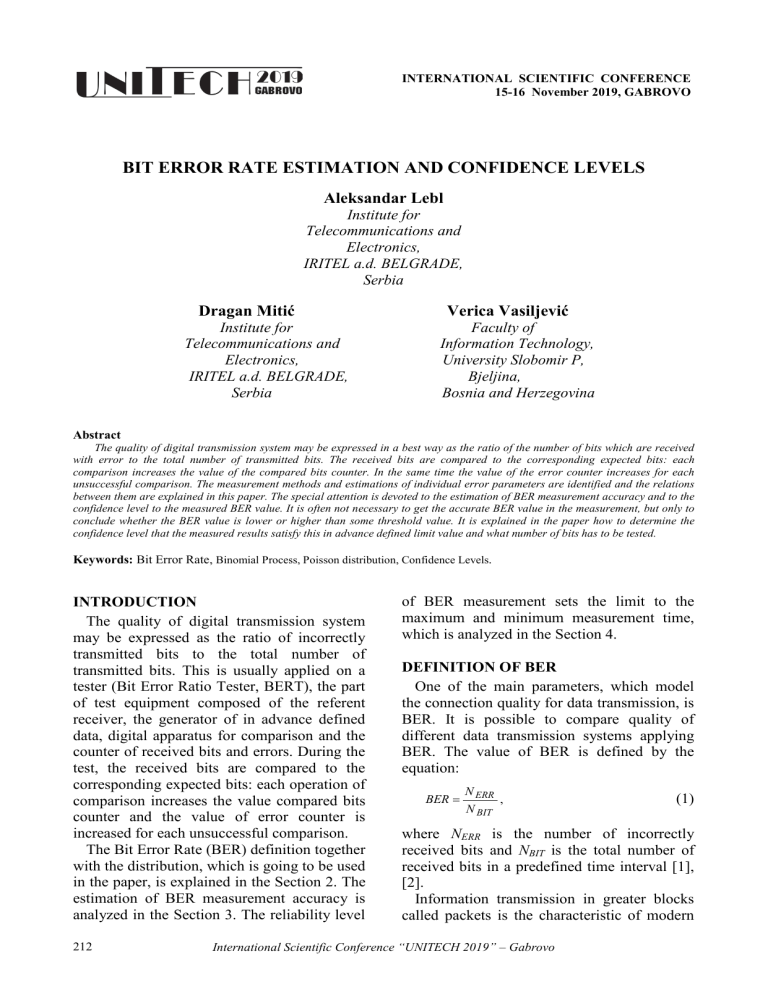
INTERNATIONAL SCIENTIFIC CONFERENCE 15-16 November 2019, GABROVO BIT ERROR RATE ESTIMATION AND CONFIDENCE LEVELS Aleksandar Lebl Institute for Telecommunications and Electronics, IRITEL a.d. BELGRADE, Serbia Dragan Mitić Institute for Telecommunications and Electronics, IRITEL a.d. BELGRADE, Serbia Verica Vasiljević Faculty of Information Technology, University Slobomir P, Bjeljina, Bosnia and Herzegovina Abstract The quality of digital transmission system may be expressed in a best way as the ratio of the number of bits which are received with error to the total number of transmitted bits. The received bits are compared to the corresponding expected bits: each comparison increases the value of the compared bits counter. In the same time the value of the error counter increases for each unsuccessful comparison. The measurement methods and estimations of individual error parameters are identified and the relations between them are explained in this paper. The special attention is devoted to the estimation of BER measurement accuracy and to the confidence level to the measured BER value. It is often not necessary to get the accurate BER value in the measurement, but only to conclude whether the BER value is lower or higher than some threshold value. It is explained in the paper how to determine the confidence level that the measured results satisfy this in advance defined limit value and what number of bits has to be tested. Keywords: Bit Error Rate, Binomial Process, Poisson distribution, Confidence Levels. INTRODUCTION The quality of digital transmission system may be expressed as the ratio of incorrectly transmitted bits to the total number of transmitted bits. This is usually applied on a tester (Bit Error Ratio Tester, BERT), the part of test equipment composed of the referent receiver, the generator of in advance defined data, digital apparatus for comparison and the counter of received bits and errors. During the test, the received bits are compared to the corresponding expected bits: each operation of comparison increases the value compared bits counter and the value of error counter is increased for each unsuccessful comparison. The Bit Error Rate (BER) definition together with the distribution, which is going to be used in the paper, is explained in the Section 2. The estimation of BER measurement accuracy is analyzed in the Section 3. The reliability level 212 of BER measurement sets the limit to the maximum and minimum measurement time, which is analyzed in the Section 4. DEFINITION OF BER One of the main parameters, which model the connection quality for data transmission, is BER. It is possible to compare quality of different data transmission systems applying BER. The value of BER is defined by the equation: BER = N ERR , N BIT (1) where NERR is the number of incorrectly received bits and NBIT is the total number of received bits in a predefined time interval [1], [2]. Information transmission in greater blocks called packets is the characteristic of modern International Scientific Conference “UNITECH 2019” – Gabrovo transmission networks. The packet content selection or recommendation depends on the network type. A phenomenon of erroneously transmitted bit causes degradation of the whole packet [3]. When considering error rate, high data content is lost. This error is determined by the relation (2) N ERP , NP N BIT ! PBIN (N ERR , N BIT , BER ) = ⋅ (N BIT − N ERR )! . Poisson PDF for lambda 5 Probability density function 0,18 0,14 0,12 0,1 0,08 0,06 0,04 0,02 0 1 0 3 2 5 4 6 8 7 9 10 11 12 13 14 15 x Poisson PDF for lambda 15 0,12 Probability density function 0,1 0,08 0,06 0,04 0,02 0 2 4 6 8 10 12 14 16 18 20 22 30 32 24 26 28 30 x (3) Poisson PDF for lambda 25 0,09 N BIT − N ERR e −λ ⋅ λ x ...... for....x = 0,1,2,.... , x! 0,16 0 Probability density function 0,08 The value PBIN presents the probability of a number of errors in the total received bits number NBIT for some BER value [4], [5]. Poisson distribution is used for modelling events in some time interval. The formula for the Poisson distribution function is: p(x; λ ) = (5) 0,2 (2) where it is: - NERP – the number of transmitted packets with at least one incorrectly transmitted bit, - NP – total number of transmitted packets. As it may be concluded from the formula (1) for BER determination, it is necessary to know the total number of transmitted bits, NBIT. This number may be assessed by continuous monitoring the number of transmitted bits. The measured error probability in transmitted bits (PBIN) is expressed by binomial distribution according to the equation [4]: ⋅ BER N ERR ⋅ (1 − BER ) µ = BER٠NBIT. 0,06 0,05 0,04 0,03 0,02 0 10 12 16 14 18 20 22 24 26 28 34 36 38 40 x Poisson PDF for lambda 35 (4) where λ is shape parameter which corresponds to the mean number of events in the selected time interval. The graph of Poisson probability density function for four values of λ is presented in the Figure 1. In the case of relatively low BER value (BER<1٠10-4) and the high number of total received bits (NBIT>1٠105), Poisson distribution approaches binomial distribution and it is possible to use simpler Poisson distribution. If the goal is to express the probability of some number of errors by Poisson distribution, it is necessary to define the parameter µ, which presents the probability 0,07 0,01 0,08 0,07 Probability density function PER = of incorrectly transmitting one bit [4], [5]. The value of µ corresponds to parameter λ, which is the mean number of events in some time interval (4). The parameter µ is defined as: 0,06 0,05 0,04 0,03 0,02 0,01 0 20 25 30 35 40 45 50 x Fig. 1. Poisson probability density function for four values of λ The probability density function (PDF) of the Poisson distribution for some BER value as the result of some measurement experiment according to (4) where λ is replaced by µ, and x is replaced by the number of erroneous bits, NERR, may be defined as: International Scientific Conference “UNITECH 2019” – Gabrovo 213 PPOISS (N ERR , µ ) = e − µ ⋅ 1 N ERR ! ⋅ µ N ERR , standard deviation for the measurement may be derived. (6) where NERR must be an integer, while µ may be any non-negative real number. The error probability for NERR erroneous bits in the total number of bits NBIT may be determined by the application of relations (3), (5), (6) and known BER values. Also the total number of transmitted bits NBIT for the BER value may be determined with the desired accuracy. If the same measurement is repeated again and again, the NERR values are distributed according to the standard deviation √µ. The NERR value is increased when µ is increased, but the PDF graph width as the function of BER is decreased (it is important to have in mind that BER is equal to µ divided to NERR). Figure 2 presents PDF functions for three µ values (µ=1, µ=10, µ=100), using BER values instead of NERR on the x-axis. The values of probabilities are normalized to 1 on y-axis. The distribution of the measured bit error ratio becomes narrower if µ is increased, which is equivalent to the number of compared bits increase if the real BER value is constant. ESTIMETION OF BER MEASUREMENT ACCURACY Normalized Probability Density Functions 1,2 1 0,8 0,6 0,4 0,2 0 0 1 2 3 4 5 6 7 Bet Error Rate x 10–12 µ=1 µ=10 µ=100 Fig. 2. Normalized Probability Density Functions for Poisson distributions with µ=1, µ=10, and µ=100, in terms of Bit Error Ratio Until now it has been supposed that real BER is known, and the derived accuracy estimates are based on this knowledge. However, the BER value is obviously unknown in real situation. How is then possible to obtain accuracy estimates after the measurements when only NBITS and NERR values are known? Fortunately, NERR may be easily used as the estimation for µ, and then 214 8 The measurements allows accuracy estimation if the PDF function which describes BER is known. As an example, three BER values on the system with the real BER value 1٠10-12 are compared, varying only the number of bits which are compared: • NBIT = 1٠1012 (µ=1). The probability to have only one error (which is equivalent to the accurate BER=10-12) is 0.3679, Figure 3; • NBIT = 1٠1013 (µ =10). The probability to have 10 errors (BER = 1٠10-12) is only 0.1215, Figure 3; • NBIT = 1٠1014 (µ=100). The probability to have 100 errors (BER = 1٠10-12) is even lower, i.e. 0.03986, Figure 3. Does it mean that the results are going to be better if the lower number of bits is compared? The situation is quite opposite. Figure 3 presents discrete PDF values for different µ=1, µ=10 and µ=100. The values of absolute probability are really higher for µ=1, but only because there are less possible outcomes. It is interesting to notice that the probability of no errors (BER=0) for µ=1 is the same as in the case of one error (BER=1٠10–12). However the probability that there are no errors is nearly zero (4.54٠10–5) for µ=10. Besides, the probability of two errors for µ=1 (BER = 2٠10–12, two-fold real value) is 0.1839, but the probability of 20 errors in the case of µ=10 (for the same BER) is only 0.00187. If one incorrectly transmitted bit NERR =1 is considered, and the accuracy PPOISS(NERR,µ) = 0.99 is required in error determination, minimum and maximum values of parameter µ may be derived by numerical methods application. The number of transmitted bits NBIT may be also determined according to (5) for the known value of BER. The values µmin = 0.1486 and µmax = 6.6384 for NERR = 1 and PPOISS (NERR,µ) = 0.99 are calculated using the program Microsoft Excel. The minimum and maximum number of received bits, NBIT (Min and Max) may be determined according to (5). The results are presented in Table 1. International Scientific Conference “UNITECH 2019” – Gabrovo Discrete Probability Density Functions 0,4 0,35 0,3 0,25 0,2 0,15 0,1 0,05 0 7 6 5 4 3 2 1 8 9 10 Number of Errors Discrete Probability Density Functions 0,14 0,12 0,1 0,08 0,06 0,04 0,02 0 1 2 3 4 5 6 7 8 9 10 11 13 12 14 15 16 17 18 19 20 Number of Errors Discrete Probability Density Functions 0,045 0,04 0,035 0,03 0,025 0,02 0,015 0,01 0,005 98 10 0 94 96 90 92 86 88 82 84 78 80 74 76 70 72 66 68 62 64 58 60 54 56 50 52 0 Number of Errors Fig. 3. Probability Density Functions for a Poisson distribution with µ=1 (first), µ=10 (second) and µ= 100 (third) Table 1. Minimum and maximum number of bits (min and max), NBIT for the defined BER, on the 99% confidence level. NBIT (bit) BER Min Max 1٠10-14 1.49٠1013 6.64٠1014 1٠10-13 1.49٠1012 6.64٠1013 -12 11 1٠10 1.49٠10 6.64٠1012 -11 10 1٠10 1.49٠10 6.64٠1011 1٠10-10 1.49٠109 6.64٠1010 -9 8 1٠10 1.49٠10 6.64٠109 -8 7 1٠10 1.49٠10 6.64٠108 1٠10-7 1.49٠106 6.64٠107 -6 5 1.49٠10 1٠10 6.64٠106 The confidence in such a statement may be expressed in the sense of confidence level. The confidence level sets the limit to the maximum or to the minimum of real value, on the base of measurements. If 3٠1012 bits are compared without detecting any error, the value of BER is under 1٠10-12 on the confidence level 95%. This example demonstrates the power of this approach: it is measured that BER=0, but applying the number of compared bits and some reasonable assumptions, it is doubtless that BER is lower than 1٠10-12. How this confidence levels may be derived? The following example may be analyzed: if 5٠1012 bits are compared and one error is obtained, is it sure that it is BER<1٠10-12? The measured value of BER is 0.2٠10-12 (1), which proves that BER is really lower than 1٠10-12, but the measurement is performed with the high uncertainty. The probabilities that there is zero or one error in 5٠1012 bits may be calculated by the application of Poisson distribution assuming that BER is exactly 1٠10-12. The values P(0.5) = 0.0067 and P(1.5) = 0.0337, may be estimated from Figure 1 for λ = 5. That’s why the probability of no or one error for 5٠1012 bits equals 4.04% (the sum of values for P(0.5) and P(1.5)) if it is BER=1٠10-12. The confidence level that BER is lower than 1٠10-12 is then 95.96%, thus providing the upper limit for BER. The Table 2 presents the statistics for the upper and lower BER limit on the confidence level 95%. In order to set the upper limit, it is necessary to transfer at least y bits with not more than x errors. When the lower limit is set, it is necessary to detect at least k errors in not more than i transferred bits. The numbers for the upper limits are derived according to the presented example, solving the equation: N ERR CONFIDENCE LEVEL OF BER MEASUREMENT In many cases it is not necessary to measure the accurate BER value, but the measurement may be stopped if the BER value is certainly under or above the limit. For example, in the tolerance test it is necessary to confirm that the device under test functions with the BER better than 1٠10–12; it doesn’t matter whether the real BER value is 1.1٠10–13 or 2.7٠10–15. ∑ PPOISS (N ERR , µ max ) = 0 ( ) , (7) = 1 − PREQ = 1 − 0,95 for µ; the number of bits necessary for the confidence level 95% is divided then by the target BER. Similar to this, the numbers for the lower limit may be derived solving N ERR ∑ PPOISS (N ERR , µ min ) = PREQ = 0,95 . 0 International Scientific Conference “UNITECH 2019” – Gabrovo (8) 215 Table 2. The statistics for the lower and the upper limit for BER = 1٠10-12 with the confidence level 95%. 95% confidence level lower limits, BER>1٠10–12 Min Min number number of compared of Errors bits (x٠10-12) 1 0.05129 2 0.3554 3 0.8117 4 1.366 5 1.970 6 2.613 7 3.285 95% confidence level upper limits, BER<1٠10–12 Max Min number number of compared of Errors bits (x٠10-12) 0 2.996 1 4.744 2 6.296 3 7.754 4 9.154 5 10.51 6 11.84 1E-11 Probability BER 1E-12 1E-13 Figure 5 presents the value of µ, which is the average number of errors as a function of the number of errors for the confidence level 99%, 95% and 90%. 25 µ, the average number of errors Unfortunately, a closed solution for these equations doesn’t exist, but they can be solved numerically. The detailed description of the alternative method for confidence level calculation by the Bayes technique [6] may be found in the Figure 3. Using the upper and lower limits presented in the Table 2, it is possible to investigate for each measurement whether BER is under or above 1٠10-12 with 95% confidence. The minimum and maximum number bits for the low number of errors are presented graphically in the Figure 4. There is a great problem when BER is near to 1٠10-12 because the reliable decision may not be made. For example, if 3٠1012 bits have been compared and two errors have been detected (the measured BER = 0.667٠10-12, (1)), the results are in the „unreliable” area in the graph between the upper and lower limit, Table 3, 1.182٠10-13, Figure 4. 20 15 10 5 0 0 1 2 3 5 4 6 7 8 9 10 Number of errors Upper limit 99% confidence Lower limit 95% confidence Lower limit 99% confidence Upper limit 90% confidence Upper limit 95% confidence Lower limit 90% confidence Fig. 5. The average number of errors µ as a function of the number of errors for the confidence level 99%, 95% and 90% In such a case it is necessary to transmit more bits until this number of bits reaches the upper limit (4.744٠1012, Table 2), or until more errors appear. If the real BER value is very near to 1٠10-12 and it is not possible to set the upper or the lower limit for BER regardless of the number of transmitted bits, the test success or failure completely depends on the application. Table 3. The statistics for the lower and the upper limit of BER = 10-12, at the confidence level 90%, 95% and 99% for NBIT = 3٠1012. Num. error Bit 0 1 2 3 4 5 6 7 8 9 10 90% confidence level lower upper limits limits 2.31 0.105 3.9 0.531 5.31 1.101 6.69 1.743 7.98 2.433 9.27 3.15 10.53 3.9 11.79 4.65 12.99 5.43 14.22 6.21 15.42 95% confidence level lower limits 0.051 0.3546 0.813 1.368 1.968 2.613 3.285 3.978 4.695 5.424 upper limits 3 4.74 6.3 7.74 9.15 10.5 11.82 13.14 14.43 15.705 16.95 99% confidence level lower upper limits limits 4.62 0.0102 6.63 0.1515 8.4 0.438 10.05 0.825 11.61 1.281 13.11 1.788 14.58 2.328 16.02 2.901 17.4 3.51 18.81 4.11 20.16 1E-14 1E-15 0 1 2 3 4 5 6 7 8 9 10 Number of errors Upper limit 90% confidence Lower limit 95% confidence Lower limit 90% confidence Upper limit 99% confidence Upper limit 95% confidence Lower limit 99% confidence Fig. 4. The BER probability presentation as a function of the number of errors for the confidence level 99%, 95% and 90% 216 CONCLUSION One of the main parameters which illustrate the quality of the data link is Bit Error Rate (BER). The quality of different data transmission systems may be compared on the base of BER. The information transfer in greater blocks called packets is applied in International Scientific Conference “UNITECH 2019” – Gabrovo modern transmission networks. The packet consists of a number of bits which may be freely selected or recommended depending on the network type. The incorrectly transferred bit causes the whole packet degradation [3], thus leading to the high data content loss. The certain number of errors in data transmission is modelled by Poisson distribution. The parameter µ has been introduced in the presented analysis. This parameter expresses the probability of one bit incorrect transmission and the corresponding parameter λ presents the mean number of events in a specified time interval, [4], [5]. It is often not necessary to measure the exact value of BER. In such a case the measurement may be stopped when it is sure that BER is under or above in advance defined limit. It is proved in a tolerance test that the tested device satisfies the BER value better than 1٠10–12; whether the real BER is 1.1٠10–13 or 2.7٠10–15 is not important. The reliability of such a statement may be expressed using confidence level. The confidence level sets the restriction to the maximum or minimum of the variable real value, based on the measurement results presented in tables and on the graphics. ACKNOWLEDGEMENT This paper is realized in the framework of project TR 32007 and TR32051, which are cofinanced by Ministry of Education, Science and Technological Republic of Serbia. Development of the REFERENCE [1] Andrea Goldsmith, Wireless Communications, 2005 by Cambridge University Press, 2005. [2] S. M. Jahangir Alam, M. Rabiul Alam, Guoqing Hu, and Md. Zakirul Mehrab, Bit Error Rate Optimization in Fiber Optic Communications, International Journal of Machine Learning and Computing, Vol. 1, No. 5, December 2011. [3] Ramin Khalili, Kavé Salamatian, A new analytic approach to evaluation of packet error rate in wireless networks, 3rd Annual Communication Networks and Services Research Conference (CNSR'05), 2005, DOI:10.1109/CNSR.2005.14. [4] Tomáš Ivaniga, Petr Ivaniga, Evaluation of the bit error rate and Q-factor in optical networks, IOSR Journal of Electronics and Communication Engineering (IOSR-JECE),eISSN: 2278-2834, p- ISSN: 2278-8735. Vo. 9, Issue 6, pp. 01-03, Ver. I (Nov - Dec. 2014). [5] Mϋeller, M., Stephens, R, Mchugh, R., Total Jitter Measurement at Low Probability Levels, Using Optimized BERT Scan Method, February 12, 2007,www.agilent.com/find/dca, http://literature.cdn.keysight.com/litweb/pdf/59 89-2933EN.pdf. [6] Casper J. Albers, Henk A. L. Kiers and Don van Ravenzwaaij, Credible Confidence: A Pragmatic View on the Frequentist vs Bayesian Debate, Collabra: Psychology, Vol.4, No.1, 31, 2018, DOI: https://doi.org/10.1525/collabra.149 International Scientific Conference “UNITECH 2019” – Gabrovo 217
